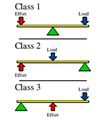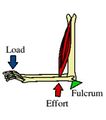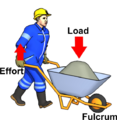Levers: Difference between revisions
From DT Online
(Corrected link) |
mNo edit summary |
||
| (8 intermediate revisions by the same user not shown) | |||
| Line 1: | Line 1: | ||
[[File: | [[File:ArchimedesLever.jpg|400px|right]] | ||
__TOC__ | |||
=====Description===== | |||
[https://en.wikipedia.org/wiki/Lever '''Levers'''] are the simplest form of mechanism and may date back to the time of the earliest civilisations. By using a stiff branch resting on a log for example, early man would have been able to move heavy loads such as rocks. This is similar to the way we might use pliers to grip, scissors to cut, or pincers to take out a nail. | [https://en.wikipedia.org/wiki/Lever '''Levers'''] are the simplest form of mechanism and may date back to the time of the earliest civilisations. By using a stiff branch resting on a log for example, early man would have been able to move heavy loads such as rocks. This is similar to the way we might use pliers to grip, scissors to cut, or pincers to take out a nail. | ||
=====Features and Applications===== | |||
A lever is a rigid beam that can rotate about a fixed point called the '''fulcrum'''. An effort applied to one end of the beam will cause a load to be moved at the other. | |||
By moving the fulcrum nearer to the load, you can lift a large load with only a little effort. ''(This is called '''[[Mechanical Advantage]]'''.)'' | |||
Levers may be considered as one of a small group of '''[[Basic Machines]]''' | Levers may be considered as one of a small group of '''[[Basic Machines]]''' first defined by early [https://en.wikipedia.org/wiki/Machine#History Greek philosophers]. [https://en.wikipedia.org/wiki/Archimedes '''Archimedes''',] in the 3rd century BC, is reported to have said: ''"Give me a place to stand, and I shall move the Earth with it"'' | ||
---- | |||
[[Category:Primary]] | |||
[[Category:Secondary]] | |||
[[Category:Mechanisms]] | [[Category:Mechanisms]] | ||
Latest revision as of 09:07, 13 July 2017
Description
Levers are the simplest form of mechanism and may date back to the time of the earliest civilisations. By using a stiff branch resting on a log for example, early man would have been able to move heavy loads such as rocks. This is similar to the way we might use pliers to grip, scissors to cut, or pincers to take out a nail.
Features and Applications
A lever is a rigid beam that can rotate about a fixed point called the fulcrum. An effort applied to one end of the beam will cause a load to be moved at the other.
By moving the fulcrum nearer to the load, you can lift a large load with only a little effort. (This is called Mechanical Advantage.)
Levers may be considered as one of a small group of Basic Machines first defined by early Greek philosophers. Archimedes, in the 3rd century BC, is reported to have said: "Give me a place to stand, and I shall move the Earth with it"
Pages in category 'Levers'
The following 5 pages are in this category, out of 5 total.
Media in category 'Levers'
The following 9 files are in this category, out of 9 total.
- ArchimedesLever.jpg 435 × 226; 36 KB
- BenchShearCompoundLever.jpg 474 × 232; 16 KB
- Lever1.png 706 × 328; 53 KB
- Lever2a.png 810 × 303; 53 KB
- LeverClasses.jpg 300 × 339; 12 KB
- MechanismsClass1Lever.jpg 300 × 207; 8 KB
- MechanismsClass2Lever.jpg 284 × 208; 8 KB
- MechanismsClass3Lever.jpg 300 × 339; 10 KB
- WheelbarrowLabelled.png 552 × 565; 219 KB








